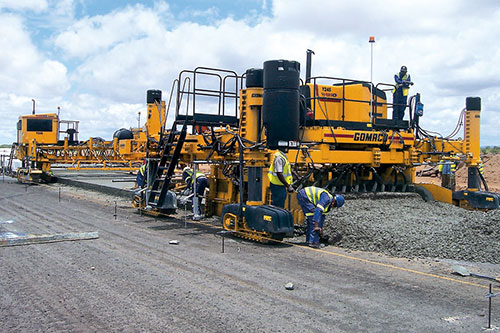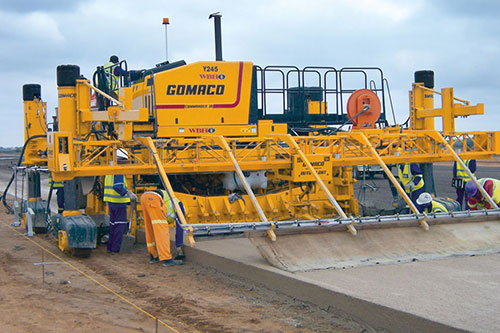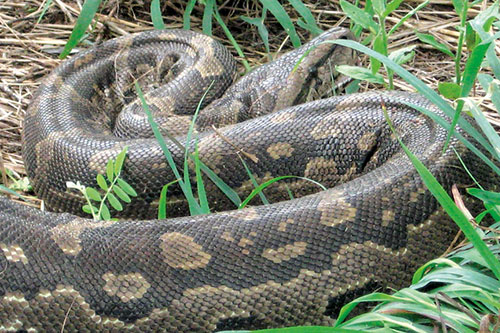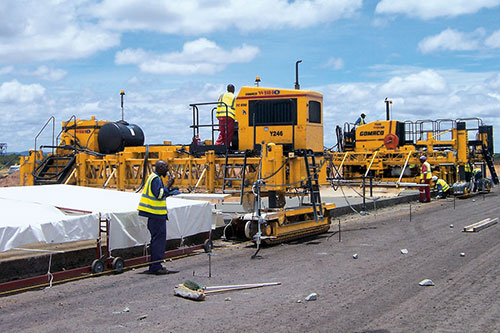GOMACO World Index --- GOMACO World 37.2 - September 2009
Runway Work on Botswana’s International Airport
A Commander III four-track slipforms a new one kilometer (0.6 mi) long runway extension on the international airport in Botswana.
The country of Botswana in southern Africa is trying to diversify its economy. They hope to do that by increasing tourism. But to do that, first they need an airport capable of handling the larger passenger jets. Last year, the country began expansion work on their Sir Seretse Khama International Airport in Gaberone.
The project, when finished, will include a new state-of-the-art terminal building, new taxiway, and a one kilometer (0.6 mi) extension to the existing runway to bring it into compliance with international requirements. The new airport expansion will increase the airport’s current average of 120 passengers per hour at peak, up to 870 passengers per hour.
Wilson Bayly Holmes-Ovcon Ltd. (WBHO) was awarded the contract that included paving the runway extension. It would be their first concrete slipform paving project, and careful consideration was given to which pieces of equipment they would purchase. Ultimately, they chose the GOMACO brand and worked closely with representatives from GOMACO International Ltd. and Meckow, GOMACO’s distributor for South Africa. WBHO’s choice for the airport, and future slipform projects, was the GOMACO four-track Commander III and T/C-600 texture/cure machine.
“The Commander III was the one universal paver that we saw,” Terry Beckermann, Director of Roads and Airport Divisions in Botswana for WBHO, said. “It allows us to pave the various widths of the airport project and do barrier and other applications on future work.”
Part of the purchase agreement included on-site training with the paving equipment. Service representatives from GOMACO taught hands-on classes, and test pours were conducted on an auxiliary apron at the airport. When it was time to start paving the actual runway, WBHO was confident in their slipforming abilities.
“The GOMACO training was very helpful and we learned a lot from them,” Beckermann said. “They taught us how to do things right and how to avoid making costly mistakes.”
The Commander III paved the runway’s passes at 4.5 meters (14.8 ft) wide and 320 millimeters (12.6 in) thick. Concrete was supplied by two on-site batch plants and hauled to the paving site by dump trucks carrying eight cubic meter (10.5 yd3) loads.
The concrete mix included large aggregate, up to 37 millimeters (1.5 in) in size, and slump averaged 30 millimeters (1.2 in). The trucks dumped the low-slump concrete directly on grade and an excavator was used to spread the concrete in front of the Commander III.
Dowel baskets were placed on grade at five meter (16.4 ft) intervals. Paving production during an eight hour work day averaged between 300-400 cubic meters (392-523 yd3) of concrete.
An Auto-Float® on the back of the Commander III finished the slab and was followed by a burlap drag. The T/C-600 texture/cure machine applied a broom finish and white spray cure to the new runway.
Paving during the summertime in Botswana presented challenges to the project with extreme heat and severe thunderstorms. When work began at 5 a.m., it was already 31 degrees C (88ºF). WBHO painted the subgrade white to help reduce the absorption of the sun’s heat by the dark subbase surface. By mid-afternoon, the aggregate at the batch plants was just too hot to maintain a quality mix. Paving was finished by 1 p.m. because of the heat, and also the tendency for afternoon thunderstorms to hit the area and potentially damage any pavement.
A series of tent structures approximately 140 meters (459 ft) long were used to protect the new concrete from the sun and rain. Sixty meters (197 ft) of the tents could be pulled along using the texture/cure machine, while the rest were moved forward by workers. Despite the extreme heat, no concrete was lost on the project.
The occasional python also created a need for caution around the work site. Workers were distracted one day when a 3.7 meter (12 ft) long baby python was found at the end of the runway. Army and airport security services had to be called in to deal with the protected species of snake. The python was removed and released into a remote part of the bush so everyone would be safe.
“We are pleased with the results of the GOMACO paver,” Beckermann said. “Airport officials did all the testing of the concrete and all the project specifications were easily met.”
Subscribe to Receive GOMACO World Magazine



